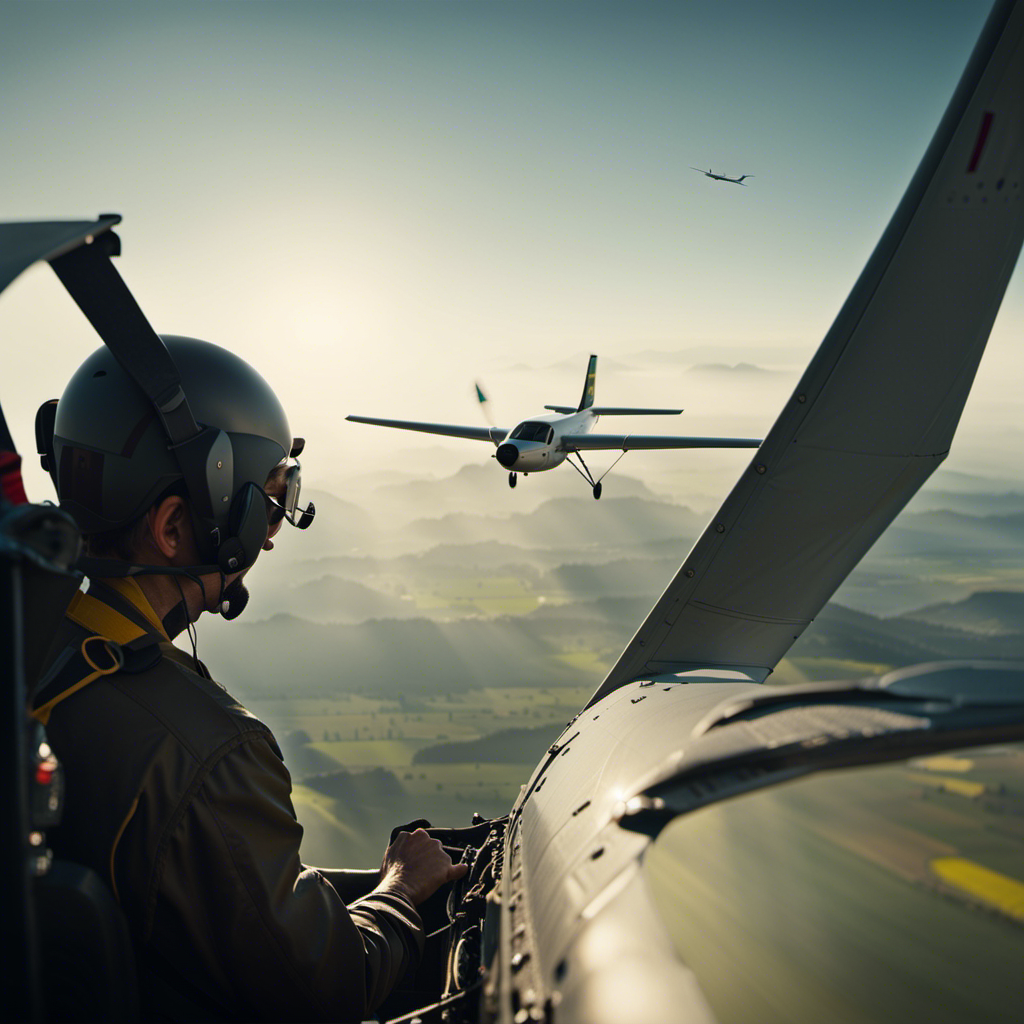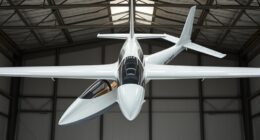As a seasoned pilot, I have always been fascinated by the art of glider towing. It’s like a graceful ballet performance between two aircrafts, requiring high levels of precision and skill.
In this article, I’ll guide you through the ins and outs of how a pilot can successfully tow a glider. From the basics of the towing procedure to the challenges and safety measures involved, we’ll explore every aspect of this exhilarating aviation practice.
So, buckle up and get ready for an exciting journey into the world of glider towing.
Key Takeaways
- Glider towing involves a process that requires training and qualifications for tow pilots.
- Maintaining speed and altitude during the tow is crucial and requires monitoring and adjustment of controls.
- Safety measures and considerations are of utmost importance in glider towing, including regular reviews of protocols and equipment maintenance.
- Overcoming challenges posed by strong winds and turbulence is necessary for a successful tow, and there are resources and training programs available for enhancing towing proficiency.
The Basics of Glider Towing
To tow a glider, you’ll need to understand the basics of glider towing. Glider towing is the process of using another aircraft, known as a tow plane, to pull the glider into the air. It requires specific training techniques and safety precautions to ensure a smooth and safe operation.
One of the most important training techniques is learning how to communicate effectively with the tow pilot through hand signals or radio communication. It is crucial to follow proper safety precautions, such as attaching the tow rope correctly and maintaining a safe distance from the tow plane.
The Role of the Tow Pilot
As a tow pilot, I understand the importance of training and qualifications required for this role. Rigorous training and certification ensure that I am well-prepared to safely tow gliders.
Additionally, I am responsible for a range of duties, including inspecting the tow aircraft and ensuring proper communication with the glider pilot. Effective communication is crucial to ensure a smooth and coordinated towing operation.
Training and qualifications required
You’ll need proper training and qualifications before you can tow a glider as a pilot. Being a tow pilot requires specific skills and knowledge to safely and effectively perform this task. Here are the key qualifications and training required:
-
Pilot’s License: To tow a glider, you must hold a valid pilot’s license, such as a Private Pilot License or a Commercial Pilot License.
-
Endorsement: You need to obtain a specific endorsement on your pilot’s license to be authorized to tow gliders. This endorsement demonstrates that you have received the necessary training and meet the requirements to safely tow gliders.
-
Tow Training: Completing a comprehensive tow training program is essential. This training covers various aspects, including the theory of towing, practical techniques, and emergency procedures.
By acquiring the appropriate qualifications and undergoing the necessary training, you will be equipped with the skills and knowledge required to safely tow gliders.
Now, let’s delve into the responsibilities and communication with the glider pilot.
Responsibilities and communication with the glider pilot
Responsibilities and communication with the glider pilot involve clear and effective coordination to ensure a safe towing operation. As the pilot responsible for towing the glider, it is crucial to establish reliable communication techniques to relay instructions and receive feedback from the glider pilot.
Safety precautions must be implemented throughout the entire towing process to minimize any potential risks. This can include conducting pre-flight inspections, adhering to weight and balance limitations, and using appropriate towing equipment. Additionally, maintaining proper spacing and altitude separation between the tow aircraft and the glider is essential to avoid any potential collisions.
By adhering to these communication techniques and safety precautions, we can ensure a smooth and secure towing operation.
Now, let’s dive into the details of the towing procedure.
The Towing Procedure
When it comes to the towing procedure, there are several key points to consider.
First and foremost, conducting thorough pre-flight checks and preparations is crucial to ensure the safety and efficiency of the tow.
Secondly, mastering takeoff and ascent techniques is essential for a smooth and controlled tow operation.
Lastly, maintaining proper speed and altitude during the tow is vital to maintain a stable flight and prevent any potential hazards.
Pre-flight checks and preparations
Before taking off, it is important to conduct pre-flight checks and preparations to ensure a safe tow of the glider. As a pilot, I understand the importance of thoroughly inspecting the glider and preparing the necessary equipment before every flight.
Here are the key steps I follow during the pre-flight inspection and equipment preparation:
-
Inspect the glider’s structure, wings, and control surfaces for any signs of damage or wear.
-
Check the control cables, rudders, and ailerons to ensure they are functioning properly.
-
Verify the security of the tow release mechanism and ensure it is in working order.
-
Prepare the tow rope, ensuring it is free from knots or frays.
-
Attach the tow rope securely to the glider’s tow hook.
-
Review the communication procedures with the tow pilot to ensure a smooth takeoff.
By diligently performing these pre-flight checks and preparations, I can ensure the safety and success of the glider tow.
Now, let’s explore the next section about takeoff and ascent techniques.
Takeoff and ascent techniques
To achieve a smooth takeoff and ascent, it’s essential to maintain a steady acceleration and keep a close eye on your airspeed. As a pilot, I know that the takeoff speed for a glider is crucial in order to generate enough lift and safely leave the ground.
Utilizing the glider controls effectively is key to achieve this. By applying the correct amount of back pressure on the control stick, I can ensure that the glider maintains the correct pitch attitude during the takeoff roll. This allows the glider to smoothly transition from ground contact to airborne.
It’s important to be precise in controlling the glider’s movements to ensure a stable ascent. Maintaining proper speed and altitude during the tow is crucial in order to safely reach the desired altitude without jeopardizing the aircraft’s performance.
Maintaining proper speed and altitude during the tow
Make sure you maintain the proper speed and altitude during the tow by closely monitoring your airspeed and staying focused on your climb. Maintaining the correct speed and altitude is crucial for a successful glider tow.
To achieve this, it is important to communicate effectively with the glider pilot. Clear and concise instructions ensure a smooth tow. Additionally, there are various techniques to help maintain speed and altitude, such as adjusting the throttle and elevator controls.
However, towing a glider does come with its challenges. Strong winds and turbulence can make it difficult to maintain the desired speed and altitude. It requires practice and skill to overcome these challenges.
Towing competitions and events provide an excellent opportunity to improve these towing skills. Resources and training programs are available to enhance towing proficiency. Safety measures and considerations should always be a top priority to ensure a safe and successful tow.
Safety Measures and Considerations
When it comes to towing gliders, there are several important safety measures and considerations that need to be taken into account.
One of the key aspects is having well-established emergency procedures and contingencies in place, in case something goes wrong during the towing process.
Additionally, weather conditions play a crucial role in towing, as strong winds or adverse weather can greatly impact the safety and stability of the tow.
Therefore, clear communication and coordination between the glider pilot and the tow pilot are of utmost importance to ensure a safe and successful towing operation.
Emergency procedures and contingencies
In case of an emergency, pilots can rely on their training to safely handle unexpected situations while towing a glider. When faced with an emergency landing scenario, it is crucial to follow these steps:
- Assess the situation and determine the best course of action.
- Communicate with the glider pilot to ensure a coordinated response.
- If necessary, release the towline to ensure a safe separation.
- Execute the emergency landing procedure, prioritizing the safety of all parties involved.
In the event of an equipment malfunction, pilots must be prepared to troubleshoot and resolve the issue promptly. This may involve:
- Identifying the malfunctioning equipment and its impact on the towing process.
- Implementing emergency procedures specific to the malfunction.
- Communicating with the glider pilot and ground crew to ensure a safe resolution.
- Conducting post-flight inspections to identify the root cause of the equipment malfunction.
Understanding emergency procedures and contingencies is vital for a safe towing operation. Now, let’s delve into another critical aspect of glider towing: weather conditions and their impact on towing.
Weather conditions and their impact on towing
Understanding the current weather conditions is crucial for determining the feasibility of towing a glider. As a pilot, I must be knowledgeable and precise when it comes to assessing the weather and its impact on towing safety.
Factors such as wind speed, direction, and turbulence can greatly affect the towing process. Strong crosswinds, for example, can make it unsafe to tow a glider, as it may become difficult to maintain control during takeoff and landing. Additionally, thunderstorms or heavy rain can create hazardous conditions for towing.
By closely monitoring the weather conditions and utilizing meteorological resources, I can make informed decisions to ensure the safety of both the glider and the towing aircraft.
Transitioning into the importance of clear communication and coordination, effective collaboration between the glider pilot and the towing pilot is essential for a successful and safe tow.
Importance of clear communication and coordination
To ensure a successful and safe tow, clear communication and coordination with the towing aircraft are essential. Both the glider pilot and the tow pilot need to be on the same page throughout the entire process. Using standardized radio communication procedures is crucial for relaying important information such as the intended flight path, changes in speed or altitude, and any potential issues or emergencies.
Coordination is equally important as it ensures that both pilots work together seamlessly. This includes coordinating the release of the glider at the appropriate time and ensuring a safe separation between the two aircraft.
By maintaining clear communication and effective coordination, pilots can maximize safety and efficiency during the towing process.
Now, let’s transition into the subsequent section about glider release and separation.
Glider Release and Separation
The pilot can safely release the glider by activating the release mechanism. Glider towing techniques require careful execution to ensure the safety of both the tow plane and the glider. Here are some safety precautions that should be followed when releasing a glider:
- Ensure that the tow plane is at a safe altitude and speed before releasing the glider.
- Communicate clearly with the tow plane pilot to coordinate the release.
- Maintain control of the glider during the release process to avoid sudden movements.
- Monitor the glider’s position and attitude after release to ensure a stable flight.
- Check for any signs of damage or malfunction before continuing the flight.
By following these safety precautions, the pilot can release the glider smoothly and safely into the air.
Now let’s explore some advanced towing techniques to enhance the gliding experience.
Advanced Towing Techniques
When utilizing advanced towing techniques, you’ll experience an enhanced gliding experience. These techniques are designed to optimize the efficiency and safety of towing a glider. One such technique is aerotowing, where a powered aircraft tows the glider using a tow line. Another technique is winch launching, where a powerful winch rapidly pulls the glider into the air. Finally, there is ground-based towing, where a vehicle tows the glider using a tow bar.
| Technique | Advantages | Challenges |
|---|---|---|
| Aerotowing | Controlled ascent | Requires two pilots |
| Winch Launching | Quick ascent | Requires a winch |
| Ground-based Towing | Cost-effective | Limited to flat terrain |
To ensure success with these advanced towing techniques, pilots must be well-trained in proper towing procedures and aware of the challenges involved. It is crucial to maintain communication and coordination with the tow pilot or ground crew. Additionally, understanding the limitations and requirements of each technique is essential for a safe and efficient tow. By mastering these techniques and being aware of the challenges, pilots can maximize the enjoyment of gliding and safely explore the skies.
Challenges and Tips for Success
Navigating the challenges of advanced towing techniques successfully requires proper training and awareness of the limitations and requirements involved.
As a pilot, I understand the challenges faced when it comes to towing a glider. One of the main challenges is ensuring a smooth takeoff and release. This requires precise coordination between the tow plane and the glider, as well as careful attention to wind conditions.
Another challenge is maintaining a safe distance and speed during the tow, while also being aware of the glider’s position at all times. To overcome these challenges, it is essential to have a thorough understanding of towing procedures, practice regularly, and communicate effectively with the tow plane pilot.
The Thrill of Glider Towing
As a tow pilot, I’ve had the privilege of experiencing the exhilarating thrill of glider towing firsthand.
Through my experiences, I’ve gained valuable perspectives on the unique challenges and rewards that come with this specialized form of aviation.
Being a tow pilot offers a variety of benefits. It provides the opportunity to hone your flying skills and experience the satisfaction of helping others reach new heights in their glider flights.
Experiences and perspectives from tow pilots
Tow pilots often find it exhilarating to guide gliders through the air. As a tow pilot myself, I have gained extensive experience in glider towing techniques and faced various challenges in tow piloting.
One of the key techniques is maintaining a steady climb angle while avoiding any abrupt maneuvers that could jeopardize the glider’s stability. This requires precise control over the tow aircraft’s speed and altitude.
Additionally, communication with the glider pilot is paramount to ensure a smooth and safe towing operation. Challenges in tow piloting include dealing with unpredictable weather conditions, such as gusty winds or thermals, which can affect the towing process.
Despite these challenges, the rewards of being a tow pilot are immense. It offers the opportunity to witness the sheer beauty of soaring flight and to play a crucial role in helping glider pilots achieve their dreams of flying freely in the sky.
Benefits and rewards of being a tow pilot
One of the benefits of being a tow pilot is the chance to experience the pure joy of witnessing gliders soaring through the sky. As a tow pilot, I have the privilege of playing a crucial role in launching gliders into the air, allowing them to take flight and explore the vast expanse above.
This unique perspective not only offers a sense of fulfillment and accomplishment but also provides a front-row seat to the incredible beauty of glider flight. The rewards of being a tow pilot extend beyond the visual spectacle. It is a testament to my skill and expertise as I navigate the delicate process of towing a glider, ensuring its safety and successful launch. It is a responsibility that brings a sense of pride and satisfaction.
Transitioning into the subsequent section about glider towing competitions and events, the excitement and thrill of being a tow pilot are further amplified in these high-stakes settings.
Glider Towing Competitions and Events
As a glider pilot, I’ve always been fascinated by the world of towing competitions. These events showcase the skills and precision of tow pilots as they navigate the challenging task of towing gliders to altitude.
Towing competitions often include various categories, such as accuracy towing and distance towing. In these categories, pilots demonstrate their ability to tow gliders with utmost precision and efficiency.
These competitions also serve as popular gatherings for tow pilots and glider enthusiasts. They offer a unique opportunity to exchange knowledge, share experiences, and celebrate the art of glider towing.
Overview of towing competitions
If you’re interested in gliding competitions, you’ll find that towing competitions offer an exciting and challenging opportunity to showcase your skills. In these competitions, pilots use towing equipment to launch gliders into the air, simulating real-life scenarios where gliders need to be towed to a suitable altitude before they can soar freely.
Towing equipment typically consists of a tow rope or cable, a tow plane, and a release mechanism. Safety precautions are paramount in towing competitions. Pilots must ensure that the tow rope is securely attached and properly maintained to avoid any mishaps during the launch. They also need to follow strict protocols for communication and coordination with the tow plane pilot to ensure a smooth and safe takeoff.
These competitions provide a thrilling platform for pilots to demonstrate their expertise in towing gliders and highlight their ability to handle challenging situations.
Moving on to popular events and gatherings for tow pilots and glider enthusiasts…
Popular events and gatherings for tow pilots and glider enthusiasts
After learning about the thrilling world of towing competitions, it’s time to explore the popular events and gatherings that bring tow pilots and glider enthusiasts together. Attending these events not only provides an opportunity to witness the skills of experienced tow pilots, but also offers a chance to network and learn from the best in the field.
Here are three must-visit events for tow pilots and glider enthusiasts:
-
The Annual Tow Pilot Symposium: This event focuses on tow pilot training and covers topics such as safety, towing techniques, and best practices. It is a great opportunity for tow pilots to enhance their skills and stay updated with the latest advancements in the field.
-
Glider Fest: This gathering brings together glider enthusiasts from all over the world to celebrate the joy of soaring. It features tow pilot demonstrations, glider exhibitions, and interactive workshops on glider towing techniques.
-
Regional Gliding Championships: These championships showcase the skills of tow pilots and glider pilots in a competitive environment. It is a thrilling event to witness, as teams compete to achieve the best tow launch and soaring performance.
With these exciting events on the horizon, let’s now delve into the various resources and training opportunities available for aspiring tow pilots and glider enthusiasts.
Resources and Training Opportunities
To find resources and training opportunities for glider towing, pilots can check with local flying clubs and organizations. These organizations often offer specialized training programs and resources to help pilots develop their skills in glider towing.
One popular resource is the Glider Towing Training Manual, which provides a comprehensive guide to the techniques and procedures involved in towing gliders.
Additionally, many flying clubs offer hands-on training sessions where pilots can practice their towing skills under the guidance of experienced instructors. These training sessions often include both classroom instruction and practical exercises, allowing pilots to develop their skills in a controlled and safe environment.
Frequently Asked Questions
What are the common types of aircraft used for glider towing?
The common types of aircraft used for glider towing are typically powered by piston or turboprop engines. These aircraft are equipped with special tow hooks and have the necessary power and aerodynamics to safely tow a glider.
What are the qualifications and experience required to become a tow pilot?
Qualifications and experience are crucial for becoming a tow pilot. A deep understanding of aviation principles, advanced flight training, and a proven track record in towing operations are essential to safely and effectively tow gliders.
How does weather conditions affect glider towing operations?
Wind speeds can greatly affect glider towing operations. Higher speeds can make it difficult for the glider to maintain a safe position behind the tow plane. Precautions include adjusting the tow line length and using appropriate aircraft configurations. Atmospheric conditions like turbulence or thermals can also impact towing operations, requiring pilots to be aware and adjust their techniques accordingly.
Are there any limitations on the size and weight of gliders that can be towed?
When it comes to towing gliders, there are indeed limitations on both size and weight. These restrictions ensure the safety and efficiency of the towing process, allowing pilots to navigate the skies with precision and confidence.
Can gliders be towed at night or in low visibility conditions?
Glider towing safety in low visibility conditions requires specialized techniques. Pilots must rely on instruments and follow strict procedures to maintain separation and ensure a safe tow. Visibility limitations can affect towing operations, requiring extra caution and adherence to regulations.
Conclusion
In conclusion, glider towing is a complex and exhilarating task that requires skill, precision, and a deep understanding of aerodynamics.
As a pilot, I have experienced the thrill of towing a glider and witnessing the beauty of flight. But it’s not just about the excitement; it’s also about the challenges and the dedication to safety.
So, the next time you see a glider soaring through the sky, ask yourself, ‘Could I handle the immense responsibility and joy of towing a glider?’









